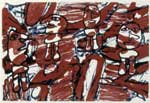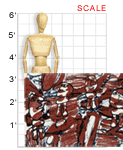VAM galleries including this work:
Jacobs Collection at Georgetown College | Seeing Red | What’s the Point? | Young at Art || VAM Home
Jean Dubuffet (French, 1901-1985)
LES PASSANTS, 1982
Print; 38" X 48"
Collection of Dr. and Mrs. Donald Jacobs
In a style typical of Jean Dubuffet, Les Passants (“The Passersby”) presents a set of figures whose cartoon-like anatomies, rather than appearing naturalistic, seem pieced together section by section. The white figures are outlined in heavy black and are obscured by a layer of red. The energy of the lines, the choice of vivid red to offset the black and white, and the open-mouthed stares of the figures create a sense of flurried activity in the print.
About the Artist
Jean Dubuffet first attracted wide attention in the years immediately following World War II. From then until his death in 1985, he remained an inventive and prolific artist. Dubuffet fought against the ordinary and banal and the pretensions of beauty in a too-cultured society. In many ways, he revolutionized the notion of what art is or what art should be.
“Many artists begin with a pig and make sausages. I begin with sausages and make a pig.”
Although he received formal training in the arts as a young man, Dubuffet did not adhere to the popular styles and trends of the day. Believing that such concepts were too far removed from reality, Dubuffet began his own search for truth in art. Following in the footsteps of Miro, he came to believe that truth was not found in the ideas and traditions of the artistic elite, but in the art of children and the mentally ill. With this innovative and provocative approach, Dubuffet made significant contributions to the breakdown of traditional interpretations of Western art.
Dubuffet coined the term l’art brut, or “art in the raw,” to describe his work. “I would like for people to look at my work as an enterprise for the rehabilitation of scorned values and, in any case, make no mistake, a work of ardent celebration.” In the 1960s, using vinyl media and a bold palette of red, blue, white, and black, Dubuffet began producing the abstract figural sculptures that he called Hourloupes. These jigsaw puzzle-like figures are made up of outlined parts that seem to be pieces of different anatomies that don’t quite fit together. (See Faribolus and Perceval in the Kentucky Center gallery for an example of the Hourloupes.)
In an explanation of the separateness of his imaginative creations, Dubuffet once said, “Many artists begin with a pig and make sausages. I begin with sausages and make a pig.” In the 1970s, he began to produce gigantic landscape sculptures that provided a maze-like atmosphere where viewers are engulfed by the work. Nearly two decades after his death, Dubuffet’s work continues to intrigue the world, as evidenced by the attendance of millions of visitors to a retrospective at the Pompidou Center in Paris in 2001.
Classroom Ideas
Discussion: Dubuffet was intrigued with and influenced by the art of children. Browse through the George Szekely Collection of Children’s Art in the Themed Galleries section of the Kentucky Virtual Art Museum. What qualities does Les Passants possess that remind you of a child’s artwork? Does this work evoke any particular mood or emotion? If so, how do you think Dubuffet achieved it?
Activity: Ignoring your preconceived notions about what constitutes “good” art, create an artwork in which your primary focus is the expression of powerful emotion and spontaneity. Feel free to incorporate characteristics you respond to in children’s art. Was the experience of creating art different than usual for you with these goals in mind? Were you more or less satisfied with the finished product? How would you compare this artwork to others you’ve created using stricter, more formal instructions or guidelines?
Links
The Dubuffet Foundation has information about the artist’s life and work.
[www.dubuffetfondation.com]
Numerous American art museums include work by Dubuffet. Two museums with extensive collections are New York’s Museum of Modern Art and the Smithsonian’s Hirshhorn Museum and Sculpture Garden.
[www.moma.org/collection/browse_results.php?criteria=O:AD:E:1633&page_number=1&template_id=6&sort_order=1]
[hirshhorn.si.edu/collection/indepth_artist.asp?ID=19]
For more links, look up Dubuffet in the Artcyclopedia.
[www.artcyclopedia.com/artists/dubuffet_jean.html]


